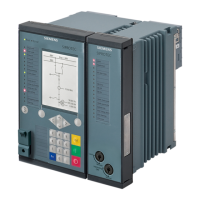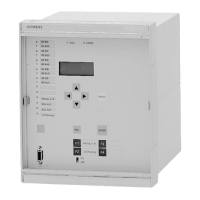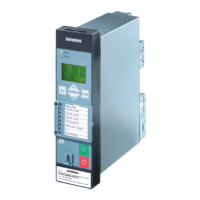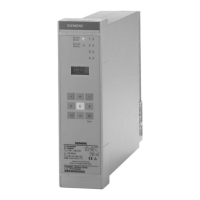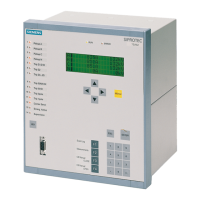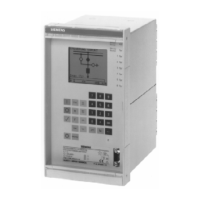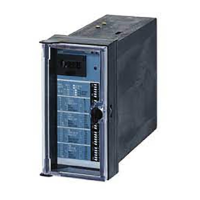Do you have a question about the Siemens 7SR12 Argus and is the answer not in the manual?
General safety guidelines for installation, operation, and maintenance of the equipment.
Overview of the relay's hardware platform, case options, and commonality between products.
Details the two available case options (E4 and E6) and their dimensions for panel mounting.
Describes the standard transparent front cover and alternative options with push buttons.
Details the five variants of the relay PSU, including auxiliary voltage and binary input threshold.
Explains the LCD display, standard keys, and indication LEDs for user interaction and configuration.
Describes the number and types of current inputs, sampling frequency, and CT ratio settings.
Details the opto-coupler operated binary inputs, their mapping, and pick-up/drop-off time delays.
Explains the configurable binary outputs, their operation modes, and assignment to functions.
Covers self-monitoring features like watchdog, memory checks, and health checks for reliable operation.
Details phase overcurrent elements, measurement methods, and directional control settings.
Explains directional elements, characteristic angle adjustment, and two-out-of-three gate logic.
Describes the instantaneous overcurrent elements, settings, and operation inhibition options.
Covers time-delayed overcurrent elements, characteristic selection, time multiplier, and reset settings.
Details sensitive earth fault protection, directional control, zero phase sequence polarising, and minimum polarising voltage.
Explains phase under/over voltage elements, voltage measurement, blocking, and hysteresis settings.
Covers under/over frequency elements, frequency calculation, and operation inhibition.
Explains the autoreclose function, its purpose, sequence control, and switching methods.
Provides an overview of the auto-reclose sequence for fault clearing and network restoration.
Details manual control commands for circuit breakers, including close, open, and blocked close delays.
Describes the feature allowing users to input logic equations in text format for custom control.
Covers the circuit breaker fail function, its time-delayed outputs, and initiation sources.
Explains VT supervision methods for detecting loss of VT phases or three-phase failure.
Details methods for detecting CT failure based on current levels and negative phase sequence components.
Describes CT supervision for 7SR11, monitoring phase currents for failure detection.
Describes communication ports (COM1, COM2, optional Ethernet) and compatible protocols.
Explains storage of relay event records, analogue/digital waveform records, and fault records.
Overview of stored data types: event, waveform, and fault records stored in non-volatile memory.
Details availability of max, min, and mean values for line currents, voltages, and power.
Explains the event recorder feature for time-tagging changes of state and logging records.
Details the three operating modes: Local, Remote, and Out of Service, and their function availability.
Describes the four settings groups and how to select active and view/edit groups.
General safety guidelines for installation, operation, and maintenance of the equipment.
Overview of the relay's hardware platform, case options, and commonality between products.
Details the two available case options (E4 and E6) and their dimensions for panel mounting.
Describes the standard transparent front cover and alternative options with push buttons.
Details the five variants of the relay PSU, including auxiliary voltage and binary input threshold.
Explains the LCD display, standard keys, and indication LEDs for user interaction and configuration.
Describes the number and types of current inputs, sampling frequency, and CT ratio settings.
Details the opto-coupler operated binary inputs, their mapping, and pick-up/drop-off time delays.
Explains the configurable binary outputs, their operation modes, and assignment to functions.
Covers self-monitoring features like watchdog, memory checks, and health checks for reliable operation.
Details phase overcurrent elements, measurement methods, and directional control settings.
Explains directional elements, characteristic angle adjustment, and two-out-of-three gate logic.
Describes the instantaneous overcurrent elements, settings, and operation inhibition options.
Covers time-delayed overcurrent elements, characteristic selection, time multiplier, and reset settings.
Details sensitive earth fault protection, directional control, zero phase sequence polarising, and minimum polarising voltage.
Explains phase under/over voltage elements, voltage measurement, blocking, and hysteresis settings.
Covers under/over frequency elements, frequency calculation, and operation inhibition.
Explains the autoreclose function, its purpose, sequence control, and switching methods.
Provides an overview of the auto-reclose sequence for fault clearing and network restoration.
Details manual control commands for circuit breakers, including close, open, and blocked close delays.
Describes the feature allowing users to input logic equations in text format for custom control.
Covers the circuit breaker fail function, its time-delayed outputs, and initiation sources.
Explains VT supervision methods for detecting loss of VT phases or three-phase failure.
Details methods for detecting CT failure based on current levels and negative phase sequence components.
Describes CT supervision for 7SR11, monitoring phase currents for failure detection.
Describes communication ports (COM1, COM2, optional Ethernet) and compatible protocols.
Explains storage of relay event records, analogue/digital waveform records, and fault records.
Overview of stored data types: event, waveform, and fault records stored in non-volatile memory.
Details availability of max, min, and mean values for line currents, voltages, and power.
Explains the event recorder feature for time-tagging changes of state and logging records.
Details the three operating modes: Local, Remote, and Out of Service, and their function availability.
Describes the four settings groups and how to select active and view/edit groups.
| Type | Protection Relay |
|---|---|
| Frequency | 50/60 Hz |
| Communication | Ethernet, RS485 |
| Rated Voltage | 230 V AC |
| Rated Current | 1A / 5A |
| Protection Functions | Overcurrent, Earth Fault |
| Communication Protocols | IEC 61850, Modbus, DNP3 |
| Operating Temperature | -25 to +70 °C |
| Enclosure | IP54 |




